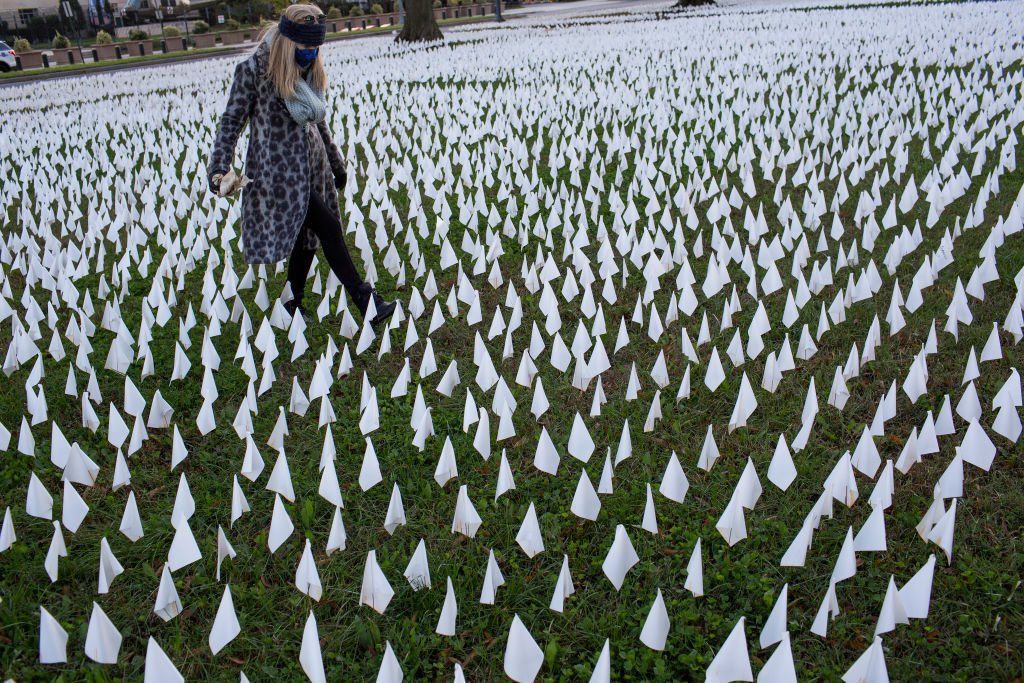
More than 300,000 people in the U.S. have died from COVID-19 as of today—a sobering figure under any circumstance, but particularly given the speed at which the the virus is killing more people.
In the past week alone, nearly 17,000 people in the U.S. have died of COVID-19. And with hundreds of thousands of new cases reported every single day, next week’s number may be even larger.
For a while, COVID-19 death rates were improving in the U.S., even as the virus continued its spread across the country. Nationally, more than 2,000 people were dying from COVID-19 each day this spring. During much of the summer, the number fell to 1,000 or fewer per day—still a staggering toll, but one at least trending in the right direction. Since then, the trend has reversed, and as of 3:30 p.m. E.T. on Dec. 14, the total death count is 300,267 according to Johns Hopkins University.
In one New York City hospital system this spring, about a quarter of people hospitalized with COVID-19 died. But by August, researchers found, that number plummeted to 7%. New treatments and better clinical knowledge among doctors certainly played a part in that progress. But the bigger factor, experts say, was hospital capacity. When hospitals in COVID-19 hotspots were overloaded in the early months of the pandemic, doctors and nurses simply didn’t have the resources to give everyone the best care possible. As case counts dropped and hospital beds freed up throughout the late spring and summer, patient outcomes improved.
Now, that progress is reversing. Case counts have shot up so high, shattering previous records, that hospitals across the country are again struggling to meet demand. On Dec. 11, a record 3,300 people in the U.S. died from the virus.
Records around COVID-19 deaths have been set and reset repeatedly in recent weeks. Judging by the massive numbers of new cases recorded each day this month, that grim cycle will continue. On Dec. 11, 231,775 new cases of coronavirus were confirmed nationwide, more than any other single day during the pandemic.
That record may not stand long, either. The U.S. is still weathering the surge in cases and deaths predicted after Thanksgiving, and another may follow the December holidays. If anything, COVID-19 cases and deaths will likely rise in the coming days and weeks.
That this news come on the same day the first COVID-19 vaccines were administered in the U.S. is bittersweet. The vaccine’s approval—hopefully the first of several—is undoubtedly cause for optimism. But experts are already warning that the vaccines’ effects will do little to slow the torrent of death and disease this winter.
A study published last month in the journal Health Affairs estimated that, even with a 95% effective vaccine like the Pfizer-BioNTech shot now rolling out in the U.S., another 160,000 people in the country will die over the next six months, given our current level of infection. “Bluntly stated, we’ll get out of this pandemic faster if we give the vaccine less work to do,” one of the study’s authors told the New York Times.
Right now, even highly effective vaccines are no match for the amount of work left to be done.
More Must-Reads from TIME
- Introducing the 2024 TIME100 Next
- The Reinvention of J.D. Vance
- How to Survive Election Season Without Losing Your Mind
- Welcome to the Golden Age of Scams
- Did the Pandemic Break Our Brains?
- The Many Lives of Jack Antonoff
- 33 True Crime Documentaries That Shaped the Genre
- Why Gut Health Issues Are More Common in Women
Write to Jamie Ducharme at jamie.ducharme@time.com